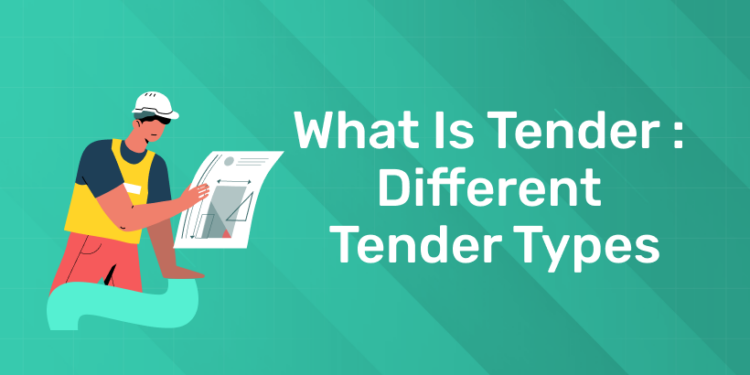Table of Contents
Sometimes government organisations or private companies invite external parties to bid to supply goods, services or take up a project. This invitation is referred to as a Tender. The type of tendering depends on the complexity of the project, the level of competition and requirements of the procuring company. In this article we shall discuss What is Tender : Different Tender Types.
Click to learn about the Quantity Surveyor online certification course!
What is Tender?
Talking in very simple terms tender can be considered as a competition in which different parties try to win a project or job through bidding.
A tender involves the following steps:
Step 1: Issuing the Job
The organisation needing the goods or job to be done will issue an announcement. It will be contain the detailed requirements. The person/organisation issuing the job is called the client or the buyer.
Step 2: Interested Party Apply
The contractor or the companies who are interested will bid to take up this project. The bid will contain details about the cost requirements, the time and how they will do the project. The interested party who bids is called bidder or tenderer.
Step 3: Reviewing the Bids
The client compares the bids proposed by all the bidders. They compare things like the quality of the plan, the price, and the experience of the companies bidding.
Step 4: Choosing a Winner
After going through the proposal the client chooses the bidder who is best suited for the job. The selection may be based on the budget, quality and reputation of the company.
Step 5: Starting the Project
Once the client chooses the winning company. They sign a contract contains the work to be done, the price and the time taken for its completion. Then the project gets started.
Tender in terms of QS
1: What is the main purpose of a Bill of Quantities (BoQ)?
In Quantity Surveying, bidding is done for construction projects or services. It involves the following steps.
Step 1: Getting Ready
Quantity Surveyor prepares a detailed document with the detailed requirement of the project, the cost involved and the time limit for the client.
Step 2: Inviting Bids
Quantity Surveyor helps the client to invite bidders for the project.
Step 3: Sending Proposals
The bidders send their proposals with how they will do the project along with their charges.
Step 4: Reviewing the Bids
Quantity Surveyor helps the client to review the proposals sent by all the bidders.
Step 5: Choosing a Winner
Finally, the client along with the Quantity Surveyor choose the best company/contractor most suitable for their project.
Step 6: Starting the work
Once the bidder is chosen. The contract is signed and the work begins.
Master Quantity Surveying – Build a Rewarding Career Today!
Gain in-demand skills in cost estimation, project budgeting, and contract management with our Quantity Surveying Course. Learn from industry experts and boost your career in construction and infrastructure. Enroll now and take the first step toward success!
Know MoreDifferent Tender Types
Different tender types are:
Open Tender:
- Open to anyone interested in bidding.
- Any company meeting the requirements can submit bids.
- Encourages competition and transparency.
- Often used for public projects.
Selective Tender:
- Only few companies selected by clients are invited
- Usually based on factors like experience, expertise, and past performance.
- Limits the number of bidders to those who are suitable.
- Can result in higher-quality bids but may reduce competition.
Single-Stage Tender:
- Bidders submit both their technical proposals and prices in one go.
- Simple and straightforward process.
- Suitable for projects with clear requirements and specifications.
- Allows for quick evaluation and decision-making.
Two-Stage Tender:
- Bidders first submit their technical proposals without prices.
- Only shortlisted bidders proceed to the second stage to submit prices.
- Provides flexibility for evaluating technical aspects before considering costs.
- Allows for innovative solutions and encourages competition.
Request for Quotation (RFQ):
- Used for smaller projects or purchases.
- Client requests prices or quotations from potential suppliers or contractors.
- Bidders respond with their quoted prices for the specified goods or services.
- Simple and efficient process for straightforward procurement.
Request for Proposal (RFP):
- Used for complex projects or services.
- Client requests detailed proposals outlining how bidders would approach the project.
- Bidders provide information on their methodologies, timelines, staffing, and costs.
- Allows for more in-depth evaluation of proposals and selection based on criteria beyond just price.
Advantages of Tender
- Fairness: Everyone gets a fair chance.
- Better Prices: Competition lowers costs.
- Best Value: Gets the most for money spent.
- Good Quality: Ensures good quality products/services.
- Fewer Risks: Spread risks among many.
- Follows Rules: Meets legal requirements.
- Looks Professional: Makes things clear and neat.
- Helps Small Businesses: Gives small companies a chance.
- Builds Trust: People believe in the process.
- Gets Things Done Right: Does things well and on time.
What is Tender : Different Tender Types: Conclusion
Tender is a competition in which different parties try to win a project or job through bidding. Different types of tenders are: selective, single-stage, two-stage, RFQ, and RFP. Each tender offers different approaches. Clients can find the best tender type to fit for their needs.
Elevate your Career with Quantity Surveyor online certification!
Master Quantity Surveying – Build a Rewarding Career Today!
Gain in-demand skills in cost estimation, project budgeting, and contract management with our Quantity Surveying Course. Learn from industry experts and boost your career in construction and infrastructure. Enroll now and take the first step toward success!
Know MoreWhat is Tender : Different Tender Types: FAQs?
1. What is a tender?
Ans. Tender is a competition in which different parties try to win a project or job through bidding.
2. Why are tenders used?
Ans. Tenders are used to ensure transparency, competition, and fairness while choosing a suitable company or contractor for the project. They allow the client to select the best-suited supplier or contractor for their needs.
3. What are the different types of tenders?
Ans. The different types of tenders are: open tender, selective tender, single-stage tender, two-stage tender, request for quotation (RFQ), and request for proposal (RFP).
4. What is an open tender?
Ans. An open tender is open to all the companies. It allows any eligible entity to submit a bid, promoting transparency and competition.
5. What is a selective tender?
Ans. In a selective tender, the client invites only selected suppliers or contractors to participate. This type of tender is used for complex projects or when specific qualifications are required.
6. What is a single-stage tender?
Ans. In a single-stage tender, bidders submit both their technical proposals and prices together. It’s a straightforward process commonly used for projects with well-defined requirements.
7. What is a two-stage tender?
Ans. A two-stage tender involves two phases. In the first stage, bidders submit their technical proposals without prices. Only shortlisted bidders proceed to the second stage to submit prices.
8. What is a request for quotation (RFQ)?
Ans. An RFQ is Used for smaller projects or purchases. In this the client requests prices or quotations from potential suppliers or contractors and bidders respond with their quoted prices for the specified goods or services.
9. What is a request for proposal (RFP)?
Ans. An RFP is used for complex projects or services. Client requests detailed proposals outlining how bidders would approach the project and the bidders provide information on their methodologies, timelines, staffing, and costs.
10. How do organizations choose the right tender type?
Ans. Organizations choose the tender type based on factors such as project size, complexity, desired level of competition, and specific requirements. Each tender type has its advantages and is suitable for different situations.
























